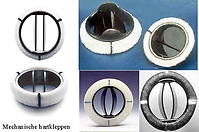Art Valves: Difference between revisions
Jump to navigation
Jump to search
(Created page with "==Different types of valve art== Before starting with echocardiographic evaluation of a valve prosthesis it is necessary to be aware of the different types of valve prosthese...") |
No edit summary |
||
| Line 3: | Line 3: | ||
Before starting with echocardiographic evaluation of a valve prosthesis it is necessary to be aware of the different types of valve prostheses. There is a difference in the kind and in the type and diameter. Thus, each manufacturer has its own characteristics. And there is a difference in whether the prosthesis is biologically or mechanically created. | Before starting with echocardiographic evaluation of a valve prosthesis it is necessary to be aware of the different types of valve prostheses. There is a difference in the kind and in the type and diameter. Thus, each manufacturer has its own characteristics. And there is a difference in whether the prosthesis is biologically or mechanically created. | ||
Click [Mechanical|here] for normal mechanical prosthesis | Click [[Mechanical|here]] for normal mechanical prosthesis | ||
Click [Biological|here] for normal biological prostheses | Click [[Biological|here]] for normal biological prostheses | ||
{| class="wikitable" cellpadding="0" cellspacing="0" border="0" width="500px" | |||
|- | |||
|[[Image:Mechkunstkleppen.jpg|300px]] | |||
|- | |||
!Mechanical prosthetic valves | |||
|} | |||
{| class="wikitable" cellpadding="0" cellspacing="0" border="0" width="500px" | |||
|- | |||
|Advantages and disadvantages of mechanical and bioprosthetic | |||
|- | |||
! | |||
!Mechanical | |||
!Biological | |||
|- | |||
!Benefits | |||
|Durable | |||
| | |||
*No anticoagulation needed | |||
*Less obstruction of the blood flow | |||
*No Leakage | |||
*Inaudible | |||
*Hemodialysis | |||
*Less risk of infection in the ring or edge flap | |||
*No pannus (tissue ingrowth) | |||
disadvantages | |||
|- | |||
!Anticoagulation needed | |||
| | |||
*Any obstruction of the blood flow | |||
*Leakage (leakage backflow after valve closure, closure backflow flap for closure. | |||
*Audible (ticks). | |||
*Hemodialysis (blood cells break down by colliding with mechanical valve. | |||
*Infection in ring or rim valve (endocarditis). | |||
*Pannus (tissue ingrowth) | |||
|Degeneration is 10-15 years | |||
|- | |||
!NB: For all valve prostheses is indicated in some cases endocarditis prophylaxis. | |||
|} | |||
==References== | ==References== | ||
Revision as of 21:54, 28 December 2013
Different types of valve art
Before starting with echocardiographic evaluation of a valve prosthesis it is necessary to be aware of the different types of valve prostheses. There is a difference in the kind and in the type and diameter. Thus, each manufacturer has its own characteristics. And there is a difference in whether the prosthesis is biologically or mechanically created.
Click here for normal mechanical prosthesis
Click here for normal biological prostheses

|
| Mechanical prosthetic valves |
|---|
| Advantages and disadvantages of mechanical and bioprosthetic | ||
| Mechanical | Biological | |
|---|---|---|
| Benefits | Durable |
disadvantages |
| Anticoagulation needed |
|
Degeneration is 10-15 years |
| NB: For all valve prostheses is indicated in some cases endocarditis prophylaxis. |
References
<biblio>
- 1 Geisinger - How the Heart Works
- 2 pmid=19065003
- 3 pmid=20375260
</biblio>